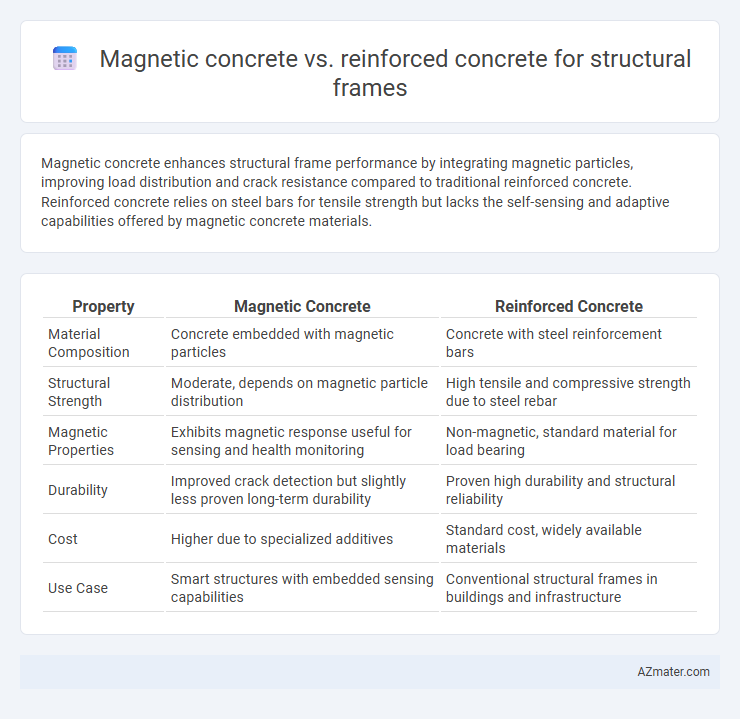Magnetic concrete enhances structural frame performance by integrating magnetic particles, improving load distribution and crack resistance compared to traditional reinforced concrete. Reinforced concrete relies on steel bars for tensile strength but lacks the self-sensing and adaptive capabilities offered by magnetic concrete materials.
Table of Comparison
| Property | Magnetic Concrete | Reinforced Concrete |
|---|---|---|
| Material Composition | Concrete embedded with magnetic particles | Concrete with steel reinforcement bars |
| Structural Strength | Moderate, depends on magnetic particle distribution | High tensile and compressive strength due to steel rebar |
| Magnetic Properties | Exhibits magnetic response useful for sensing and health monitoring | Non-magnetic, standard material for load bearing |
| Durability | Improved crack detection but slightly less proven long-term durability | Proven high durability and structural reliability |
| Cost | Higher due to specialized additives | Standard cost, widely available materials |
| Use Case | Smart structures with embedded sensing capabilities | Conventional structural frames in buildings and infrastructure |
Introduction: Understanding Magnetic and Reinforced Concrete
Magnetic concrete incorporates ferromagnetic materials to enhance electromagnetic properties, allowing for novel applications in structural monitoring and smart infrastructure. Reinforced concrete traditionally combines concrete with steel rebar, providing high compressive strength and tensile resistance essential for durable structural frames. Comparing these materials highlights magnetic concrete's potential for sensing capabilities, while reinforced concrete remains the standard for load-bearing performance in construction engineering.
Defining Magnetic Concrete: Composition and Properties
Magnetic concrete is a composite material integrating ferromagnetic particles such as iron oxide within traditional concrete, enhancing its magnetic permeability and enabling electromagnetic applications in structural frames. Its unique composition offers improved sensing capabilities and interaction with magnetic fields compared to conventional reinforced concrete, which relies solely on steel reinforcement for tensile strength. These properties make magnetic concrete suitable for smart infrastructure monitoring and electromagnetic interference mitigation in advanced structural designs.
Reinforced Concrete: Traditional Choice for Structural Frames
Reinforced concrete remains the traditional choice for structural frames due to its superior compressive strength and ability to accommodate tensile forces through embedded steel reinforcement. It offers excellent durability, fire resistance, and cost-effectiveness for large-scale construction projects, making it a reliable material in the building industry. While magnetic concrete introduces innovative properties for electromagnetic applications, reinforced concrete continues to dominate structural frame design for its proven performance and well-established engineering standards.
Mechanical Strength: Which Material Performs Better?
Magnetic concrete, enhanced with ferromagnetic additives, demonstrates improved mechanical strength by increasing tensile and compressive capacities compared to conventional reinforced concrete, which relies on embedded steel bars for reinforcement. Studies indicate that magnetic concrete exhibits higher resistance to crack propagation and better load-bearing performance under dynamic stresses, making it more durable in structural frames subjected to variable loads. Reinforced concrete remains effective for standard applications, but magnetic concrete's advanced properties offer superior mechanical performance in demanding structural frame scenarios.
Durability and Lifespan Comparison
Magnetic concrete incorporates ferromagnetic materials that enhance crack detection and maintenance efficiency, potentially extending its lifespan compared to traditional reinforced concrete. Reinforced concrete combines steel reinforcement with concrete to provide strong structural integrity but may suffer from corrosion over time, reducing durability. Studies show magnetic concrete exhibits improved resistance to environmental degradation, leading to a longer service life in structural frame applications.
Construction Techniques: Installation and Adaptability
Magnetic concrete integrates iron particles that enhance magnetic properties, allowing for innovative installation methods like magnetic alignment and faster curing through electromagnetic fields, significantly reducing construction time compared to traditional reinforced concrete. Reinforced concrete relies on steel rebar placement within formworks, requiring precise manual positioning and longer curing periods, which can limit adaptability to complex geometries. The adaptability of magnetic concrete improves structural flexibility and simplifies retrofitting processes, whereas reinforced concrete offers proven robustness but demands more labor-intensive techniques during installation.
Cost Analysis: Magnetic vs Reinforced Concrete
Magnetic concrete typically incurs higher initial costs due to specialized materials and manufacturing processes compared to conventional reinforced concrete, which benefits from widespread availability and established supply chains. Reinforced concrete offers cost-effective scalability for structural frames, whereas magnetic concrete may reduce long-term expenses through enhanced durability and maintenance savings. Life-cycle cost analysis often favors reinforced concrete for budget-sensitive projects, while magnetic concrete shows promise in applications demanding superior performance despite higher upfront investment.
Applications in Modern Building Projects
Magnetic concrete, integrating ferromagnetic materials, enhances electromagnetic shielding and electromagnetic field control in structural frames, making it ideal for high-tech buildings and data centers. Reinforced concrete remains the standard choice for most modern building projects due to its superior load-bearing capacity and versatility in structural applications like beams, columns, and slabs. Emerging applications of magnetic concrete focus on improving structural health monitoring and smart infrastructure capabilities, complementing traditional reinforced concrete frameworks.
Sustainability and Environmental Impact
Magnetic concrete incorporates ferromagnetic materials that enhance structural durability and enable electromagnetic applications, potentially reducing the need for additional reinforcement and lowering cement consumption, which decreases carbon emissions. Reinforced concrete relies heavily on steel rebar, whose production is energy-intensive and contributes significantly to greenhouse gas emissions. Utilizing magnetic concrete can improve sustainability by reducing resource extraction, minimizing environmental footprint, and promoting innovative recycling methods for spent materials in structural frames.
Future Trends: Innovations in Structural Concrete Technology
Magnetic concrete integrates magnetic nanoparticles to enhance structural integrity and enable self-sensing capabilities, revolutionizing future building monitoring systems compared to traditional reinforced concrete, which relies on steel rebar for tensile strength. Innovations in magnetic concrete technology aim to improve durability, reduce maintenance costs, and facilitate real-time health assessments through embedded sensors, pushing the boundaries of smart infrastructure. Research trends emphasize sustainable materials and multifunctional properties in structural frames, positioning magnetic concrete as a transformative solution in next-generation construction technology.

Infographic: Magnetic concrete vs Reinforced concrete for Structural frame
 azmater.com
azmater.com